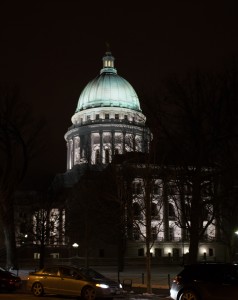This camera story starts with my long simmering desire to own a full frame camera. I’ve been in the Canon camp since 2004, and have owned several really nice lenses, a Canon L USM 17-40mm zoom, and a Canon L USM 24-105mm. I started out with a 10D body (stolen on vacation), moved to a 30D. These bodies are APS-C, which means the sensor is smaller than full frame, and thus the lens undergoes a multiplication factor (essentially a zoom) of 1.6. It has always worked fine, good quality pictures, but it came to bug me that a good portion of the deliverable light of my lens pair was being “thrown away”.
At some point in my development, I purchases a used Olympus Four Thirds system e-420, for the unbelievable price of $300, perfect body, two sweet lenses, camera bag, other goodies. This setup weighed half that of my Canon rig, and the quality just blew me away. Paradigm shift . . .
I gave this camera to my Dad because it was small and easy to use, and in the pursuit of going even lighter, picked up an Olympus micro four/thirds PEN PL5. This camera also took great photos and was smaller yet, weighing all of a pound. It did have the disadvantage of being so physically small that the controls were not easy to manipulate in the field. After a year with this camera, it came to my attention loud and clear that I was using it 95% of the time over my much heavier Canon setup. I guess I don’t like a stone around my neck as much as I used to.
Back to full frame SLRs. The a7 came to my attention and I read up on it for a good year, thinking I’d be able to finally have full frame and take advantage of my two Canon zooms, and have a light body, all in one. It helped that it was advertised as being “the smallest full frame SLR made”.
Finally I pulled the trigger in early January 2015, body only. This mirrorless SLR has garnered a reputation for being compatible with lenses from almost every lens maker out there. A small industry of Sony to <whatever> lens adaptors has sprung up around the a7.
Lenses:
Decades ago, my Dad gave up on being a serious photographer and handed me his Nikon bag. It had a lot of lenses and his old film body, an FE model. I also shot Nikon back in the day (an FM body being my last film camera), mostly Kodochrome slides. I also still have several Nikon lenses. And it occurred to me that all these lenses were fair game for the Sony, as long as I could relearn to shoot in manual mode. Between the two bags, I ended up with this treasure trove:
Nikon Prime lenses:
Nikkor 24mm : 283g
Nikkor 28mm : 276g
Nikkor 50mm : 258g
Nikon Series E 50mm
Nikon Zooms:
Nikkor 24-120mm
Nikkor 35-135mm
Nikkor 35-105mm
Osawa 80-205 mm
It’s ironic. I almost threw this stuff away, I thought all of it was essentially worthless. Twenty-thirty years later, these lenses are doing great on this Sony a7. Old Nikon lenses are sharp, esp the primes. For their small size, they are heavy! Quality glass. Irony #2 – I probably won’t even use the Canon lenses on the Sony. The adaptor is expensive, the end result is heavy, and the purported performance is rated marginal.
I’ve taken a couple hundred pics with the Sony, here’s some sample work. All these were shot RAW and processed in Lightroom, with jpgs exported for this slide show. Shots in the neighborhood, mostly. The point here is to demonstrate sharpness. In some cases, high ISO was used. It didn’t seem to hurt picture quality as much as one would think. In a few cases I did use the ISO smoothing feature in Lightroom. But mostly these pictures have very little post processing applied to them.
All RAW images are 24M size, I use Lightroom5 to create JPGs in the range of 1M +/-. These are uploaded to Smugmug, and launched from here.
(click thumbnail for gallery)

